Talent Planning and Success of an Organisation: Argos Report
VerifiedAdded on 2020/12/09
|20
|4657
|387
Report
AI Summary
This report delves into the critical aspects of talent planning and workforce management, using Argos as a case study. It begins by analyzing current market trends impacting talent planning, such as globalization, environmental sustainability, demographic changes, technological advancements, and urbanization. The report then outlines the various legal requirements essential for effective workforce planning, including the Equality Act of 2010, anti-discrimination acts, fair HRM policies, and maternity/paternity benefits. Furthermore, it determines current and anticipated skills requirements based on labour market trends and legal mandates. The report also provides detailed job descriptions and person specifications for effective recruitment and selection processes, alongside a discussion of different recruitment and selection methods. Finally, the report evaluates the stages of the HR life-cycle applied to specific HR contexts and explores how these stages are integrated within the organizational HR strategy, concluding with key findings and recommendations for Argos.
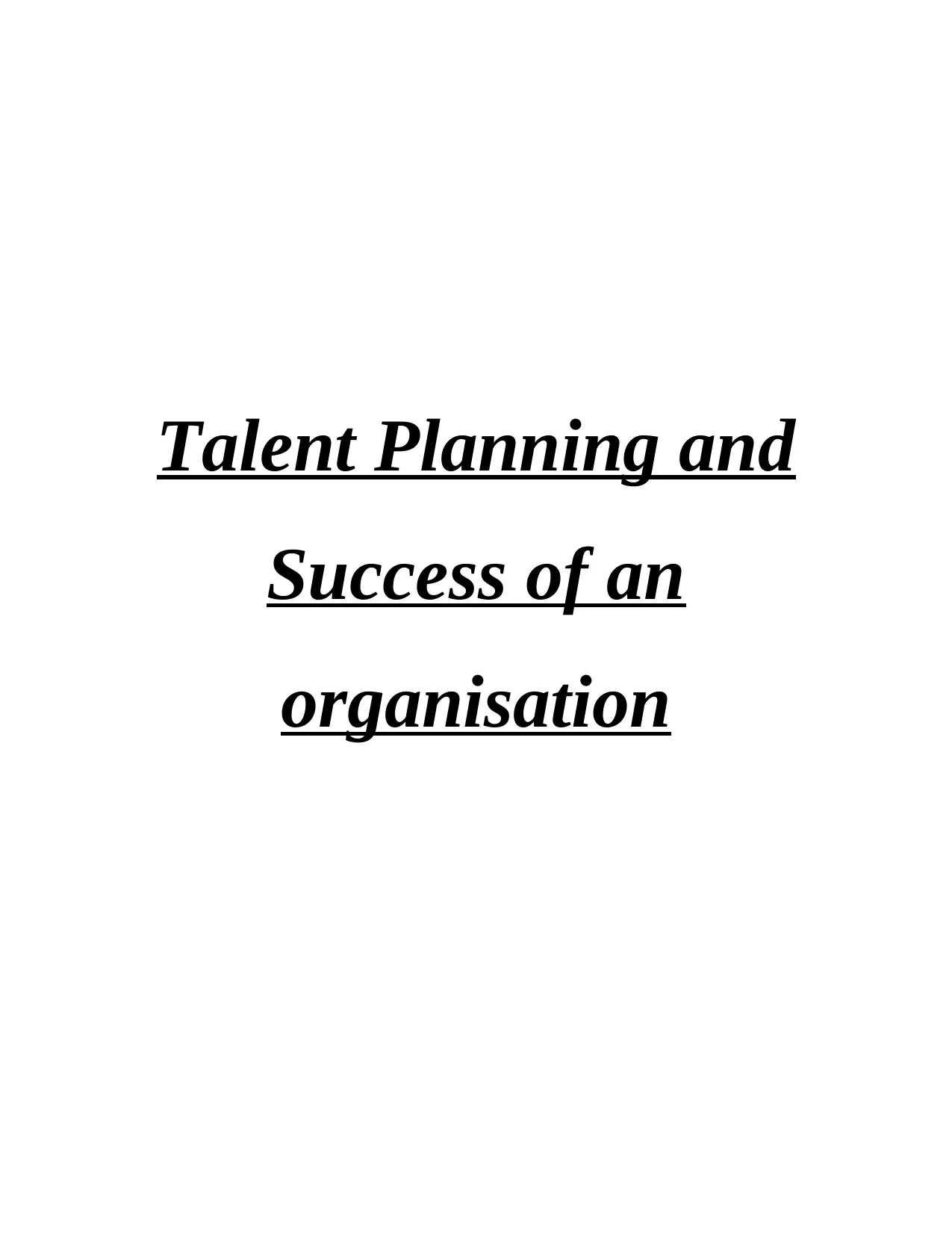
Talent Planning and
Success of an
organisation
Success of an
organisation
Paraphrase This Document
Need a fresh take? Get an instant paraphrase of this document with our AI Paraphraser

Table of Contents
INTRODUCTION....................................................................................................................... 1
INTRODUCTION....................................................................................................................... 1
TASK 1....................................................................................................................................... 1
P1. Analysis of current market trends that lay an impact on talent planning and workforce.....1
P2. State various types of legal requirements that are needed while workforce planning.........3
TASK 2....................................................................................................................................... 4
P3.Based on current labour market trends and legal requirements determine current and
anticipated skills requirements for a range of organisational examples....................................4
P4. Job description and person specification documents for effective recruitment and selection
................................................................................................................................................ 6
P5.Different recruitment and selection method........................................................................8
TASK 4....................................................................................................................................... 9
P6 Evaluate the stages of the HR life-cycle applied to specific HR contexts............................9
P7. Stages of the HR life-cycle are integrated within organisational HR strategy..................10
CONCLUSION.......................................................................................................................... 11
REFERENCES......................................................................................................................... 13
CONCLUSION.......................................................................................................................... 15
REFERENCES.......................................................................................................................... 16
INTRODUCTION....................................................................................................................... 1
INTRODUCTION....................................................................................................................... 1
TASK 1....................................................................................................................................... 1
P1. Analysis of current market trends that lay an impact on talent planning and workforce.....1
P2. State various types of legal requirements that are needed while workforce planning.........3
TASK 2....................................................................................................................................... 4
P3.Based on current labour market trends and legal requirements determine current and
anticipated skills requirements for a range of organisational examples....................................4
P4. Job description and person specification documents for effective recruitment and selection
................................................................................................................................................ 6
P5.Different recruitment and selection method........................................................................8
TASK 4....................................................................................................................................... 9
P6 Evaluate the stages of the HR life-cycle applied to specific HR contexts............................9
P7. Stages of the HR life-cycle are integrated within organisational HR strategy..................10
CONCLUSION.......................................................................................................................... 11
REFERENCES......................................................................................................................... 13
CONCLUSION.......................................................................................................................... 15
REFERENCES.......................................................................................................................... 16

INTRODUCTION
INTRODUCTION
Talent planning is an important function and management practice. This is an
overarching strategy that comprehend how an organisation plans for having the talent it needs in
critical situations both in present as well as in the future. This is an ongoing process along with
its life-cycle which includes planning, developing, replacing, promoting and selecting, etc. The
purpose of talent planning is to retain the valuable employees (Elango, 2017). In this report
Argos is taken as the chosen organisation, which is a British catalogue retailer company founded
in 1972 by Richard Tompkins. Argos is subsidiary company of Sainsbury which has their head
office in England. The present report will put light on the the purpose of examine the current
labour market trends that are influenced by talent management team organisation. Along with
this, the study also show the different kinds of legal requirement at the time of workforce
planing. Appropriate job description and person specification documents for effective
recruitment and selection method is also been discussed. In the end, the report will be wind up
by describing the life cycle of HR along with various strategies that can be used by an HR
manager so that the aims and set of objectives can be attained.
TASK 1
l P1. Analysis of current market trends that lay an impact on talent planning and
workforce.
Workforce planning is an essential process or framework that exists as an action plan
which is generally considered or used by managers whenever needs and requirements of labour
force have to examined. It is an important strategic tool that helps managers and leaders of
Argos in preparing them against any critical situations or opportunities that may arise in near
future. There are a number of advantages or benefits that workforce planning has such as
identification of talents, retaining employees for a longer time etc.
Talent planning on the other hand refers to a process which involves a series of steps
such as hiring, recruiting, retaining of employees etc (Tarigan, 2017). In present context, market
INTRODUCTION
Talent planning is an important function and management practice. This is an
overarching strategy that comprehend how an organisation plans for having the talent it needs in
critical situations both in present as well as in the future. This is an ongoing process along with
its life-cycle which includes planning, developing, replacing, promoting and selecting, etc. The
purpose of talent planning is to retain the valuable employees (Elango, 2017). In this report
Argos is taken as the chosen organisation, which is a British catalogue retailer company founded
in 1972 by Richard Tompkins. Argos is subsidiary company of Sainsbury which has their head
office in England. The present report will put light on the the purpose of examine the current
labour market trends that are influenced by talent management team organisation. Along with
this, the study also show the different kinds of legal requirement at the time of workforce
planing. Appropriate job description and person specification documents for effective
recruitment and selection method is also been discussed. In the end, the report will be wind up
by describing the life cycle of HR along with various strategies that can be used by an HR
manager so that the aims and set of objectives can be attained.
TASK 1
l P1. Analysis of current market trends that lay an impact on talent planning and
workforce.
Workforce planning is an essential process or framework that exists as an action plan
which is generally considered or used by managers whenever needs and requirements of labour
force have to examined. It is an important strategic tool that helps managers and leaders of
Argos in preparing them against any critical situations or opportunities that may arise in near
future. There are a number of advantages or benefits that workforce planning has such as
identification of talents, retaining employees for a longer time etc.
Talent planning on the other hand refers to a process which involves a series of steps
such as hiring, recruiting, retaining of employees etc (Tarigan, 2017). In present context, market
⊘ This is a preview!⊘
Do you want full access?
Subscribe today to unlock all pages.

Trusted by 1+ million students worldwide
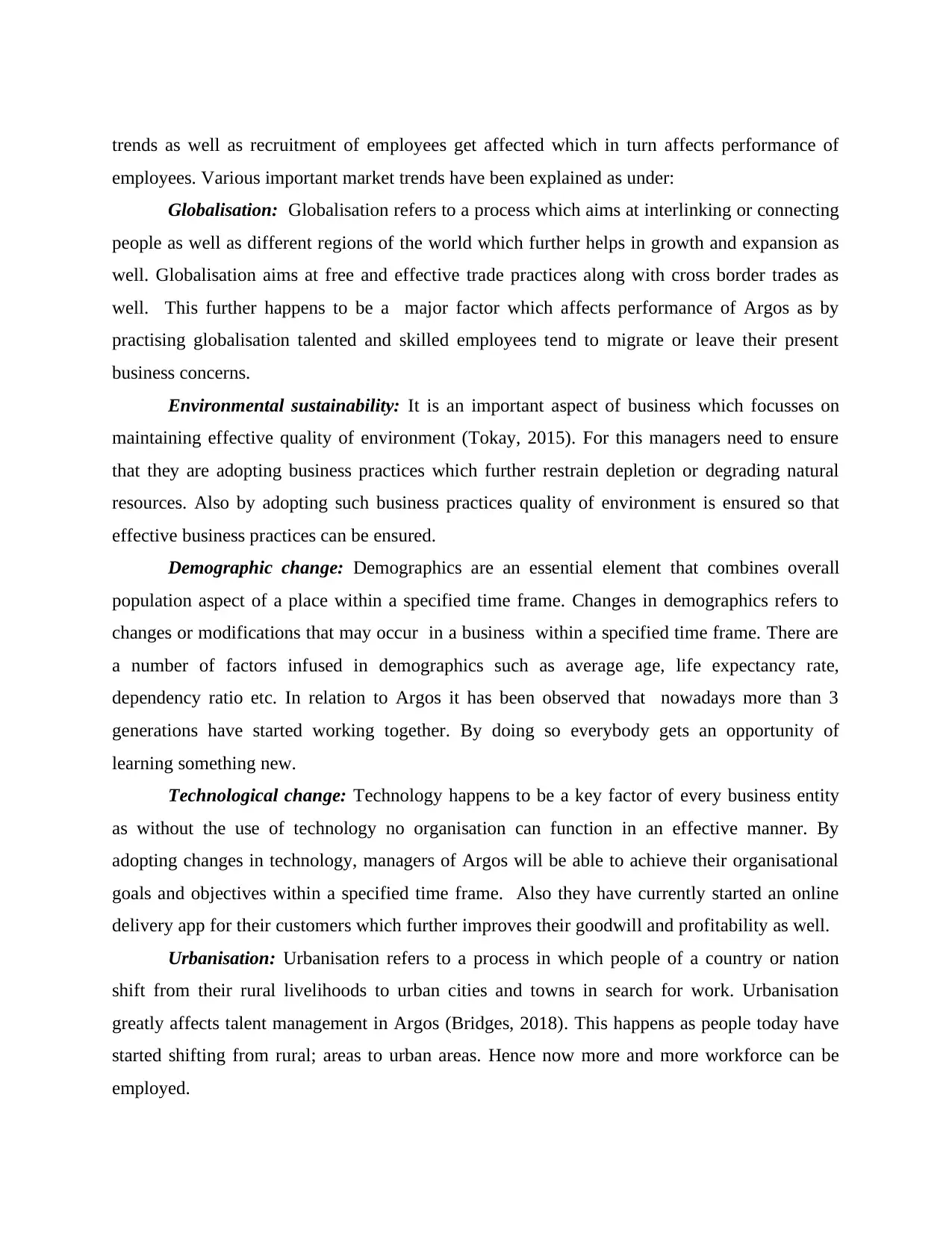
trends as well as recruitment of employees get affected which in turn affects performance of
employees. Various important market trends have been explained as under:
Globalisation: Globalisation refers to a process which aims at interlinking or connecting
people as well as different regions of the world which further helps in growth and expansion as
well. Globalisation aims at free and effective trade practices along with cross border trades as
well. This further happens to be a major factor which affects performance of Argos as by
practising globalisation talented and skilled employees tend to migrate or leave their present
business concerns.
Environmental sustainability: It is an important aspect of business which focusses on
maintaining effective quality of environment (Tokay, 2015). For this managers need to ensure
that they are adopting business practices which further restrain depletion or degrading natural
resources. Also by adopting such business practices quality of environment is ensured so that
effective business practices can be ensured.
Demographic change: Demographics are an essential element that combines overall
population aspect of a place within a specified time frame. Changes in demographics refers to
changes or modifications that may occur in a business within a specified time frame. There are
a number of factors infused in demographics such as average age, life expectancy rate,
dependency ratio etc. In relation to Argos it has been observed that nowadays more than 3
generations have started working together. By doing so everybody gets an opportunity of
learning something new.
Technological change: Technology happens to be a key factor of every business entity
as without the use of technology no organisation can function in an effective manner. By
adopting changes in technology, managers of Argos will be able to achieve their organisational
goals and objectives within a specified time frame. Also they have currently started an online
delivery app for their customers which further improves their goodwill and profitability as well.
Urbanisation: Urbanisation refers to a process in which people of a country or nation
shift from their rural livelihoods to urban cities and towns in search for work. Urbanisation
greatly affects talent management in Argos (Bridges, 2018). This happens as people today have
started shifting from rural; areas to urban areas. Hence now more and more workforce can be
employed.
employees. Various important market trends have been explained as under:
Globalisation: Globalisation refers to a process which aims at interlinking or connecting
people as well as different regions of the world which further helps in growth and expansion as
well. Globalisation aims at free and effective trade practices along with cross border trades as
well. This further happens to be a major factor which affects performance of Argos as by
practising globalisation talented and skilled employees tend to migrate or leave their present
business concerns.
Environmental sustainability: It is an important aspect of business which focusses on
maintaining effective quality of environment (Tokay, 2015). For this managers need to ensure
that they are adopting business practices which further restrain depletion or degrading natural
resources. Also by adopting such business practices quality of environment is ensured so that
effective business practices can be ensured.
Demographic change: Demographics are an essential element that combines overall
population aspect of a place within a specified time frame. Changes in demographics refers to
changes or modifications that may occur in a business within a specified time frame. There are
a number of factors infused in demographics such as average age, life expectancy rate,
dependency ratio etc. In relation to Argos it has been observed that nowadays more than 3
generations have started working together. By doing so everybody gets an opportunity of
learning something new.
Technological change: Technology happens to be a key factor of every business entity
as without the use of technology no organisation can function in an effective manner. By
adopting changes in technology, managers of Argos will be able to achieve their organisational
goals and objectives within a specified time frame. Also they have currently started an online
delivery app for their customers which further improves their goodwill and profitability as well.
Urbanisation: Urbanisation refers to a process in which people of a country or nation
shift from their rural livelihoods to urban cities and towns in search for work. Urbanisation
greatly affects talent management in Argos (Bridges, 2018). This happens as people today have
started shifting from rural; areas to urban areas. Hence now more and more workforce can be
employed.
Paraphrase This Document
Need a fresh take? Get an instant paraphrase of this document with our AI Paraphraser
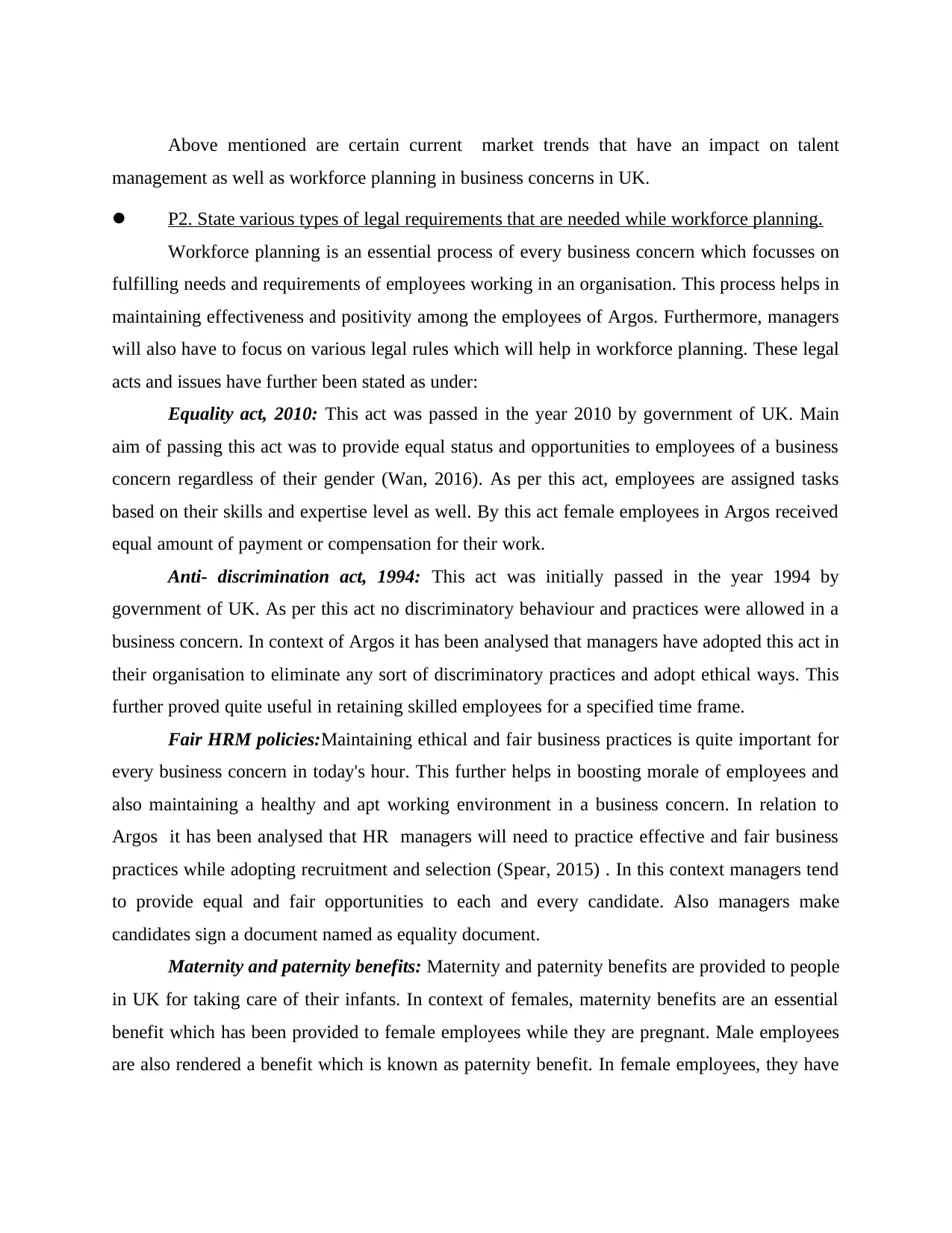
Above mentioned are certain current market trends that have an impact on talent
management as well as workforce planning in business concerns in UK.
l P2. State various types of legal requirements that are needed while workforce planning.
Workforce planning is an essential process of every business concern which focusses on
fulfilling needs and requirements of employees working in an organisation. This process helps in
maintaining effectiveness and positivity among the employees of Argos. Furthermore, managers
will also have to focus on various legal rules which will help in workforce planning. These legal
acts and issues have further been stated as under:
Equality act, 2010: This act was passed in the year 2010 by government of UK. Main
aim of passing this act was to provide equal status and opportunities to employees of a business
concern regardless of their gender (Wan, 2016). As per this act, employees are assigned tasks
based on their skills and expertise level as well. By this act female employees in Argos received
equal amount of payment or compensation for their work.
Anti- discrimination act, 1994: This act was initially passed in the year 1994 by
government of UK. As per this act no discriminatory behaviour and practices were allowed in a
business concern. In context of Argos it has been analysed that managers have adopted this act in
their organisation to eliminate any sort of discriminatory practices and adopt ethical ways. This
further proved quite useful in retaining skilled employees for a specified time frame.
Fair HRM policies:Maintaining ethical and fair business practices is quite important for
every business concern in today's hour. This further helps in boosting morale of employees and
also maintaining a healthy and apt working environment in a business concern. In relation to
Argos it has been analysed that HR managers will need to practice effective and fair business
practices while adopting recruitment and selection (Spear, 2015) . In this context managers tend
to provide equal and fair opportunities to each and every candidate. Also managers make
candidates sign a document named as equality document.
Maternity and paternity benefits: Maternity and paternity benefits are provided to people
in UK for taking care of their infants. In context of females, maternity benefits are an essential
benefit which has been provided to female employees while they are pregnant. Male employees
are also rendered a benefit which is known as paternity benefit. In female employees, they have
management as well as workforce planning in business concerns in UK.
l P2. State various types of legal requirements that are needed while workforce planning.
Workforce planning is an essential process of every business concern which focusses on
fulfilling needs and requirements of employees working in an organisation. This process helps in
maintaining effectiveness and positivity among the employees of Argos. Furthermore, managers
will also have to focus on various legal rules which will help in workforce planning. These legal
acts and issues have further been stated as under:
Equality act, 2010: This act was passed in the year 2010 by government of UK. Main
aim of passing this act was to provide equal status and opportunities to employees of a business
concern regardless of their gender (Wan, 2016). As per this act, employees are assigned tasks
based on their skills and expertise level as well. By this act female employees in Argos received
equal amount of payment or compensation for their work.
Anti- discrimination act, 1994: This act was initially passed in the year 1994 by
government of UK. As per this act no discriminatory behaviour and practices were allowed in a
business concern. In context of Argos it has been analysed that managers have adopted this act in
their organisation to eliminate any sort of discriminatory practices and adopt ethical ways. This
further proved quite useful in retaining skilled employees for a specified time frame.
Fair HRM policies:Maintaining ethical and fair business practices is quite important for
every business concern in today's hour. This further helps in boosting morale of employees and
also maintaining a healthy and apt working environment in a business concern. In relation to
Argos it has been analysed that HR managers will need to practice effective and fair business
practices while adopting recruitment and selection (Spear, 2015) . In this context managers tend
to provide equal and fair opportunities to each and every candidate. Also managers make
candidates sign a document named as equality document.
Maternity and paternity benefits: Maternity and paternity benefits are provided to people
in UK for taking care of their infants. In context of females, maternity benefits are an essential
benefit which has been provided to female employees while they are pregnant. Male employees
are also rendered a benefit which is known as paternity benefit. In female employees, they have
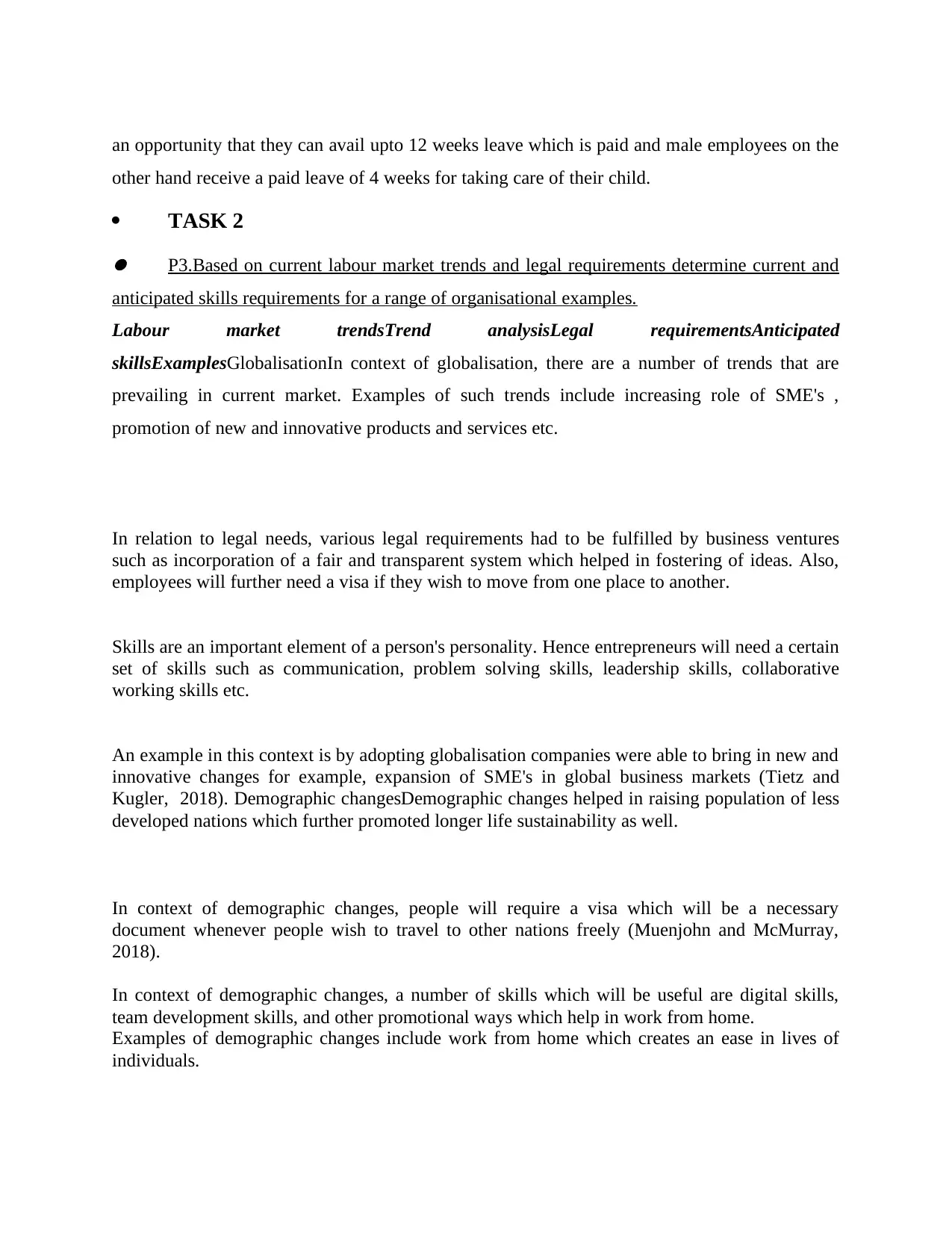
an opportunity that they can avail upto 12 weeks leave which is paid and male employees on the
other hand receive a paid leave of 4 weeks for taking care of their child.
TASK 2
l P3.Based on current labour market trends and legal requirements determine current and
anticipated skills requirements for a range of organisational examples.
Labour market trendsTrend analysisLegal requirementsAnticipated
skillsExamplesGlobalisationIn context of globalisation, there are a number of trends that are
prevailing in current market. Examples of such trends include increasing role of SME's ,
promotion of new and innovative products and services etc.
In relation to legal needs, various legal requirements had to be fulfilled by business ventures
such as incorporation of a fair and transparent system which helped in fostering of ideas. Also,
employees will further need a visa if they wish to move from one place to another.
Skills are an important element of a person's personality. Hence entrepreneurs will need a certain
set of skills such as communication, problem solving skills, leadership skills, collaborative
working skills etc.
An example in this context is by adopting globalisation companies were able to bring in new and
innovative changes for example, expansion of SME's in global business markets (Tietz and
Kugler, 2018). Demographic changesDemographic changes helped in raising population of less
developed nations which further promoted longer life sustainability as well.
In context of demographic changes, people will require a visa which will be a necessary
document whenever people wish to travel to other nations freely (Muenjohn and McMurray,
2018).
In context of demographic changes, a number of skills which will be useful are digital skills,
team development skills, and other promotional ways which help in work from home.
Examples of demographic changes include work from home which creates an ease in lives of
individuals.
other hand receive a paid leave of 4 weeks for taking care of their child.
TASK 2
l P3.Based on current labour market trends and legal requirements determine current and
anticipated skills requirements for a range of organisational examples.
Labour market trendsTrend analysisLegal requirementsAnticipated
skillsExamplesGlobalisationIn context of globalisation, there are a number of trends that are
prevailing in current market. Examples of such trends include increasing role of SME's ,
promotion of new and innovative products and services etc.
In relation to legal needs, various legal requirements had to be fulfilled by business ventures
such as incorporation of a fair and transparent system which helped in fostering of ideas. Also,
employees will further need a visa if they wish to move from one place to another.
Skills are an important element of a person's personality. Hence entrepreneurs will need a certain
set of skills such as communication, problem solving skills, leadership skills, collaborative
working skills etc.
An example in this context is by adopting globalisation companies were able to bring in new and
innovative changes for example, expansion of SME's in global business markets (Tietz and
Kugler, 2018). Demographic changesDemographic changes helped in raising population of less
developed nations which further promoted longer life sustainability as well.
In context of demographic changes, people will require a visa which will be a necessary
document whenever people wish to travel to other nations freely (Muenjohn and McMurray,
2018).
In context of demographic changes, a number of skills which will be useful are digital skills,
team development skills, and other promotional ways which help in work from home.
Examples of demographic changes include work from home which creates an ease in lives of
individuals.
⊘ This is a preview!⊘
Do you want full access?
Subscribe today to unlock all pages.

Trusted by 1+ million students worldwide
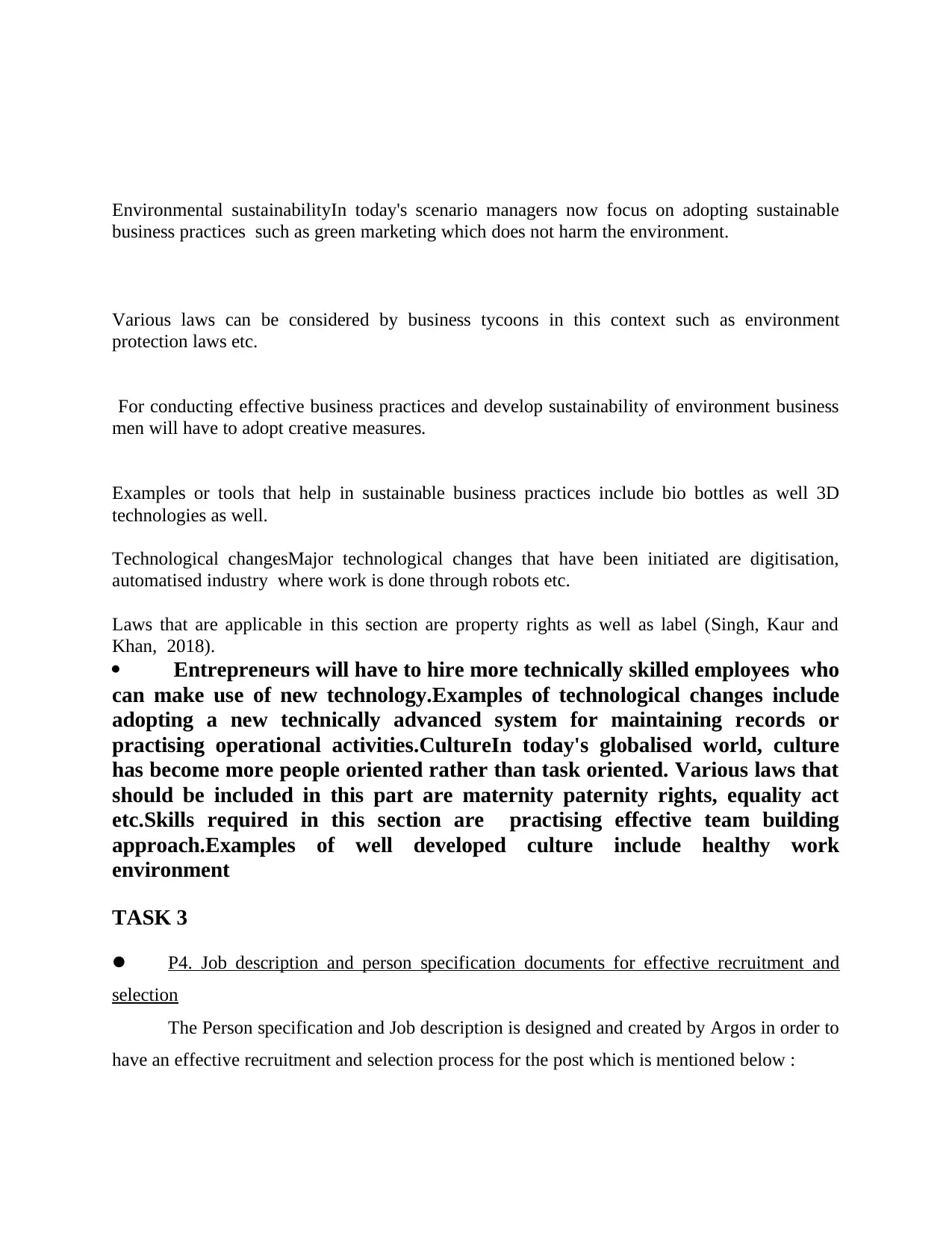
Environmental sustainabilityIn today's scenario managers now focus on adopting sustainable
business practices such as green marketing which does not harm the environment.
Various laws can be considered by business tycoons in this context such as environment
protection laws etc.
For conducting effective business practices and develop sustainability of environment business
men will have to adopt creative measures.
Examples or tools that help in sustainable business practices include bio bottles as well 3D
technologies as well.
Technological changesMajor technological changes that have been initiated are digitisation,
automatised industry where work is done through robots etc.
Laws that are applicable in this section are property rights as well as label (Singh, Kaur and
Khan, 2018).
Entrepreneurs will have to hire more technically skilled employees who
can make use of new technology.Examples of technological changes include
adopting a new technically advanced system for maintaining records or
practising operational activities.CultureIn today's globalised world, culture
has become more people oriented rather than task oriented. Various laws that
should be included in this part are maternity paternity rights, equality act
etc.Skills required in this section are practising effective team building
approach.Examples of well developed culture include healthy work
environment
TASK 3
l P4. Job description and person specification documents for effective recruitment and
selection
The Person specification and Job description is designed and created by Argos in order to
have an effective recruitment and selection process for the post which is mentioned below :
business practices such as green marketing which does not harm the environment.
Various laws can be considered by business tycoons in this context such as environment
protection laws etc.
For conducting effective business practices and develop sustainability of environment business
men will have to adopt creative measures.
Examples or tools that help in sustainable business practices include bio bottles as well 3D
technologies as well.
Technological changesMajor technological changes that have been initiated are digitisation,
automatised industry where work is done through robots etc.
Laws that are applicable in this section are property rights as well as label (Singh, Kaur and
Khan, 2018).
Entrepreneurs will have to hire more technically skilled employees who
can make use of new technology.Examples of technological changes include
adopting a new technically advanced system for maintaining records or
practising operational activities.CultureIn today's globalised world, culture
has become more people oriented rather than task oriented. Various laws that
should be included in this part are maternity paternity rights, equality act
etc.Skills required in this section are practising effective team building
approach.Examples of well developed culture include healthy work
environment
TASK 3
l P4. Job description and person specification documents for effective recruitment and
selection
The Person specification and Job description is designed and created by Argos in order to
have an effective recruitment and selection process for the post which is mentioned below :
Paraphrase This Document
Need a fresh take? Get an instant paraphrase of this document with our AI Paraphraser

Job Description – This can be described as the ceremonial document which includes all the
general tasks and other related roles and responsibilities of a particular job profile (Arraya,
Pellissier and Preto, 2015).
Job Description
Job Details
Post : HR generalist
Company : Argos Ltd. Job Purpose : HR generalist in Argos Ltd has the role to manage day-
to-day HR operations. Also will responsible to manage the policies, programmes and procedures
of the organisation.Roles & Responsibilities
The one should assist in talent acquisition and recruitment processes.
Conduct the employee on-boarding and help to plan training and development
programmes.
The one should administrates the compensation and benefits the plans and performance
management.
The one has the duty to investigate the complaints which are forwarded by the
employees.
Preparing and maintaining reports related to specific HR projects
Assisting with monitoring and evaluating the budget and payroll.
Developing methods for compiling and analysing data for reports and special projects
Conducting the research to remain up-to-date about the new HR trends and practices.
Create and submit the report on the activities of HR generalist.
general tasks and other related roles and responsibilities of a particular job profile (Arraya,
Pellissier and Preto, 2015).
Job Description
Job Details
Post : HR generalist
Company : Argos Ltd. Job Purpose : HR generalist in Argos Ltd has the role to manage day-
to-day HR operations. Also will responsible to manage the policies, programmes and procedures
of the organisation.Roles & Responsibilities
The one should assist in talent acquisition and recruitment processes.
Conduct the employee on-boarding and help to plan training and development
programmes.
The one should administrates the compensation and benefits the plans and performance
management.
The one has the duty to investigate the complaints which are forwarded by the
employees.
Preparing and maintaining reports related to specific HR projects
Assisting with monitoring and evaluating the budget and payroll.
Developing methods for compiling and analysing data for reports and special projects
Conducting the research to remain up-to-date about the new HR trends and practices.
Create and submit the report on the activities of HR generalist.
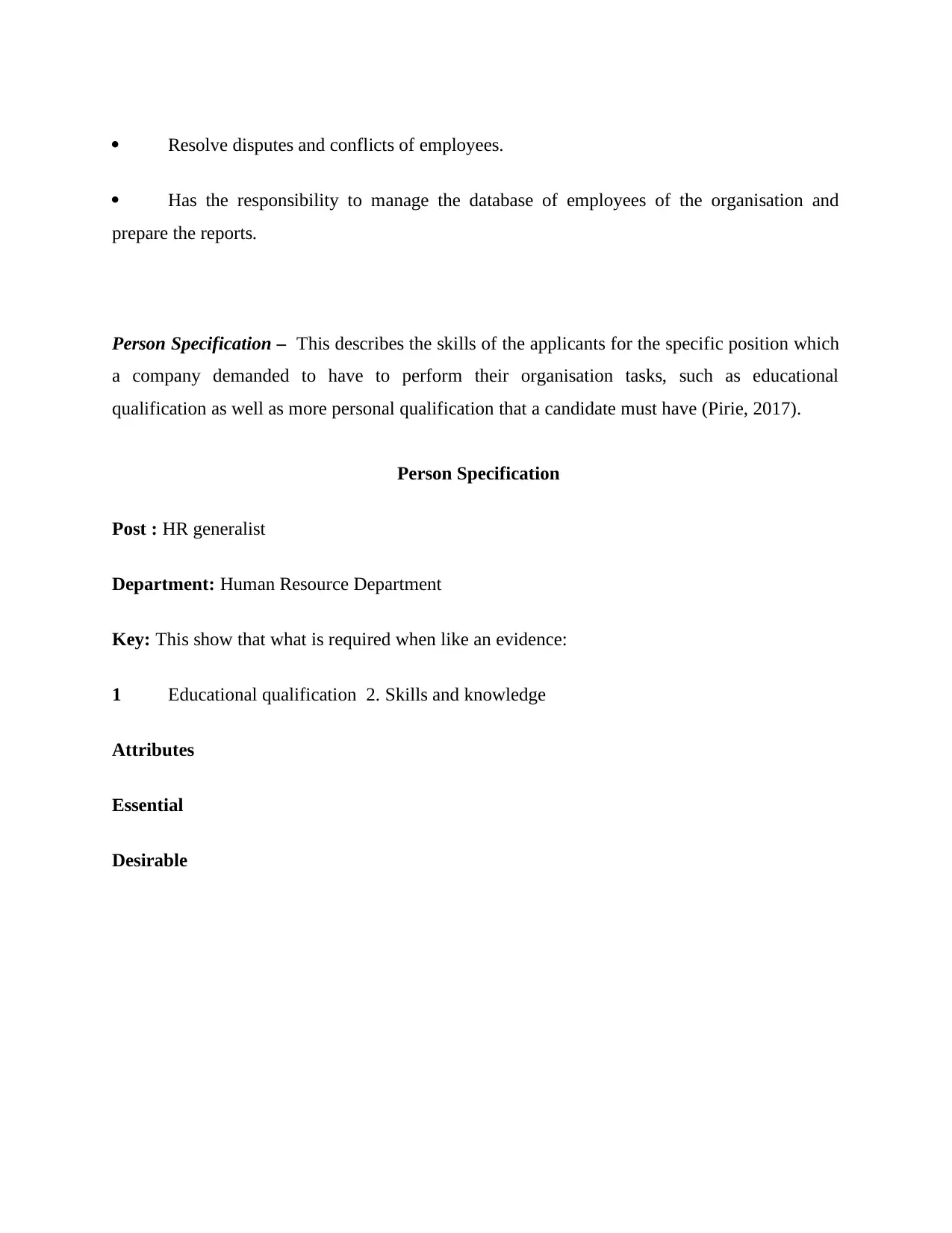
Resolve disputes and conflicts of employees.
Has the responsibility to manage the database of employees of the organisation and
prepare the reports.
Person Specification – This describes the skills of the applicants for the specific position which
a company demanded to have to perform their organisation tasks, such as educational
qualification as well as more personal qualification that a candidate must have (Pirie, 2017).
Person Specification
Post : HR generalist
Department: Human Resource Department
Key: This show that what is required when like an evidence:
1 Educational qualification 2. Skills and knowledge
Attributes
Essential
Desirable
Has the responsibility to manage the database of employees of the organisation and
prepare the reports.
Person Specification – This describes the skills of the applicants for the specific position which
a company demanded to have to perform their organisation tasks, such as educational
qualification as well as more personal qualification that a candidate must have (Pirie, 2017).
Person Specification
Post : HR generalist
Department: Human Resource Department
Key: This show that what is required when like an evidence:
1 Educational qualification 2. Skills and knowledge
Attributes
Essential
Desirable
⊘ This is a preview!⊘
Do you want full access?
Subscribe today to unlock all pages.

Trusted by 1+ million students worldwide

Qualification & Experience
MBA and BBA with human resource as specialisation from an authorised college. Minimum 3
to 5 years of working experience as a HR generalist.
Experience of working in human resource department as a HR generalist.
MBA and BBA with human resource as specialisation from an authorised college. Minimum 3
to 5 years of working experience as a HR generalist.
Experience of working in human resource department as a HR generalist.
Paraphrase This Document
Need a fresh take? Get an instant paraphrase of this document with our AI Paraphraser
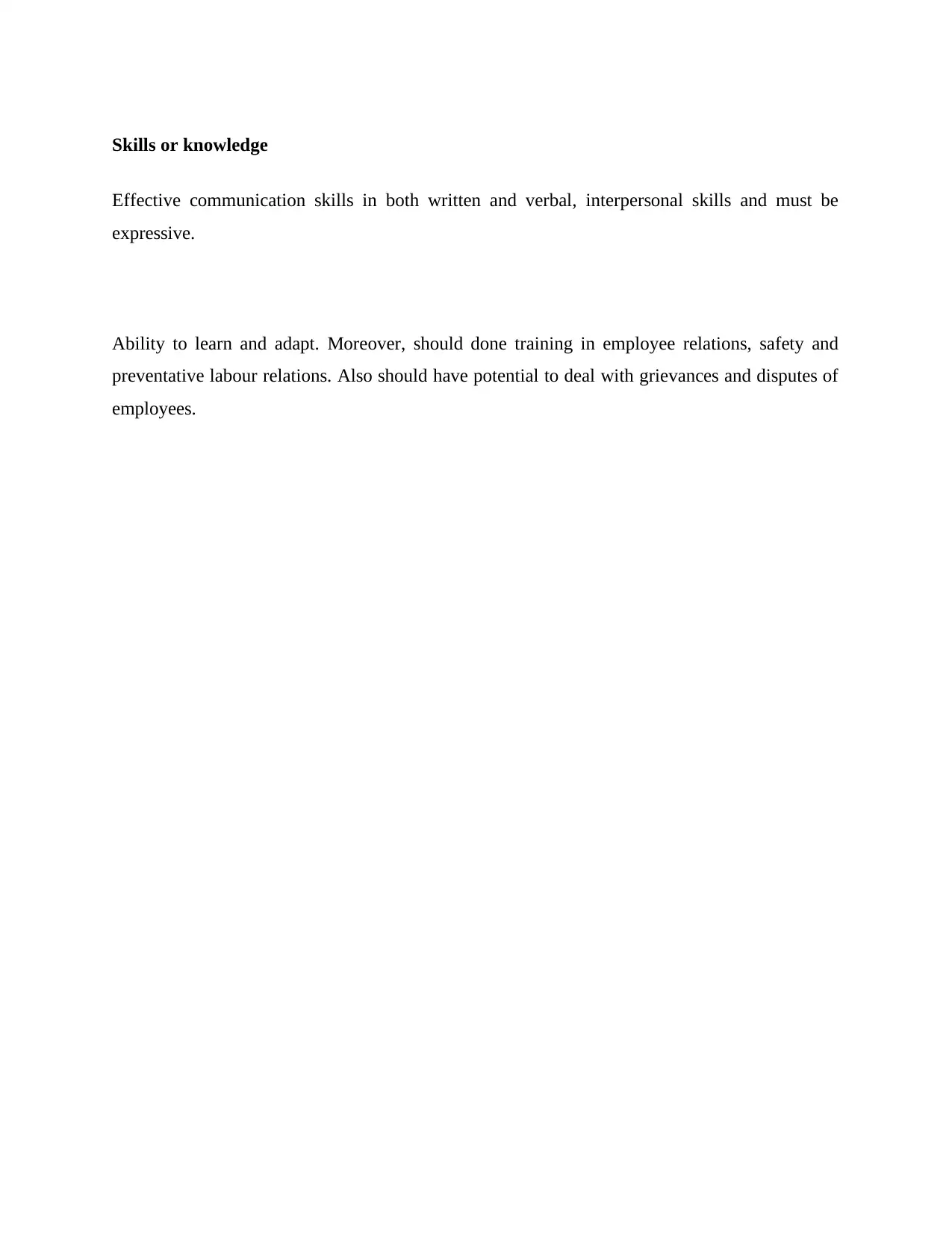
Skills or knowledge
Effective communication skills in both written and verbal, interpersonal skills and must be
expressive.
Ability to learn and adapt. Moreover, should done training in employee relations, safety and
preventative labour relations. Also should have potential to deal with grievances and disputes of
employees.
Effective communication skills in both written and verbal, interpersonal skills and must be
expressive.
Ability to learn and adapt. Moreover, should done training in employee relations, safety and
preventative labour relations. Also should have potential to deal with grievances and disputes of
employees.
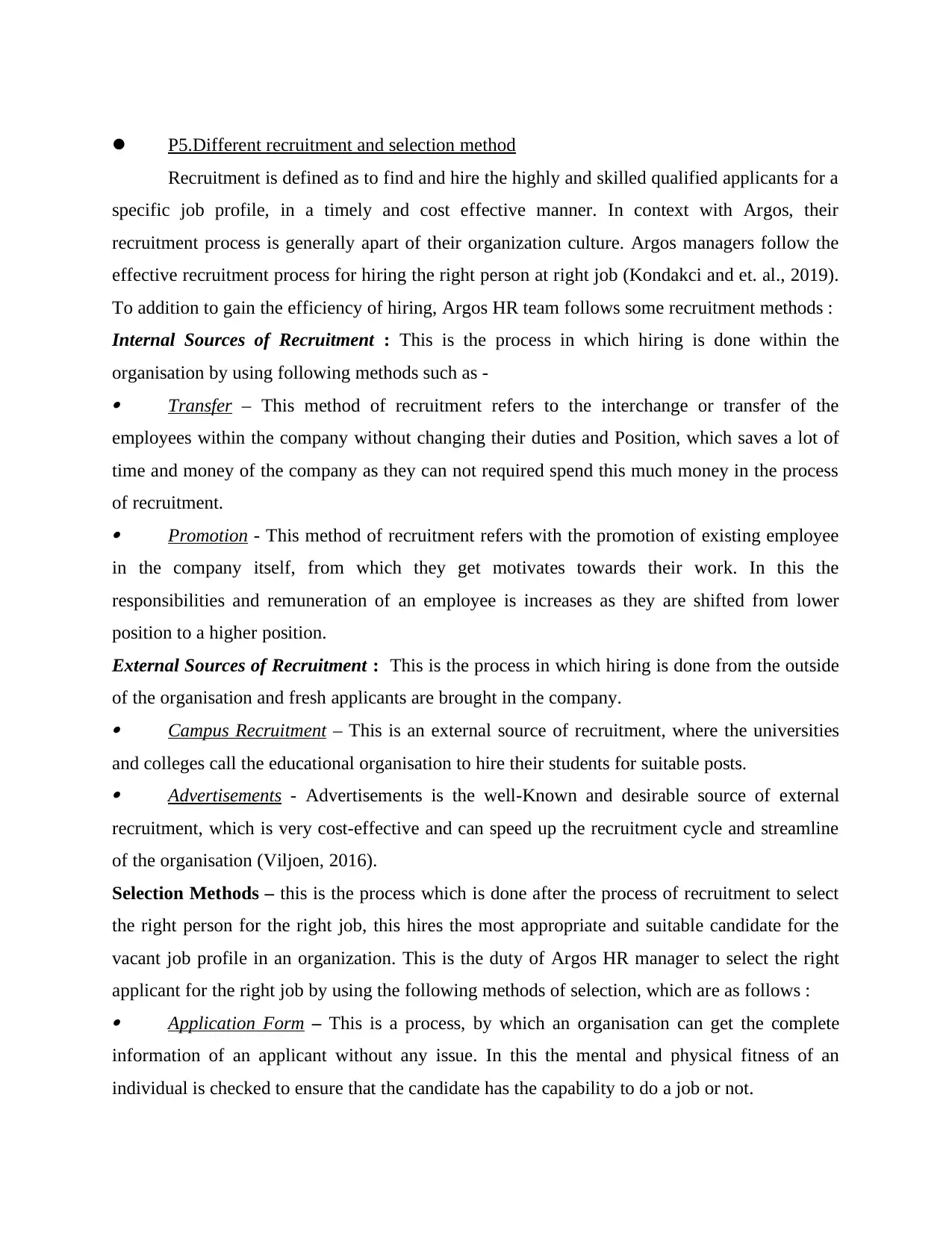
l P5.Different recruitment and selection method
Recruitment is defined as to find and hire the highly and skilled qualified applicants for a
specific job profile, in a timely and cost effective manner. In context with Argos, their
recruitment process is generally apart of their organization culture. Argos managers follow the
effective recruitment process for hiring the right person at right job (Kondakci and et. al., 2019).
To addition to gain the efficiency of hiring, Argos HR team follows some recruitment methods :
Internal Sources of Recruitment : This is the process in which hiring is done within the
organisation by using following methods such as - Transfer – This method of recruitment refers to the interchange or transfer of the
employees within the company without changing their duties and Position, which saves a lot of
time and money of the company as they can not required spend this much money in the process
of recruitment. Promotion - This method of recruitment refers with the promotion of existing employee
in the company itself, from which they get motivates towards their work. In this the
responsibilities and remuneration of an employee is increases as they are shifted from lower
position to a higher position.
External Sources of Recruitment : This is the process in which hiring is done from the outside
of the organisation and fresh applicants are brought in the company. Campus Recruitment – This is an external source of recruitment, where the universities
and colleges call the educational organisation to hire their students for suitable posts. Advertisements - Advertisements is the well-Known and desirable source of external
recruitment, which is very cost-effective and can speed up the recruitment cycle and streamline
of the organisation (Viljoen, 2016).
Selection Methods – this is the process which is done after the process of recruitment to select
the right person for the right job, this hires the most appropriate and suitable candidate for the
vacant job profile in an organization. This is the duty of Argos HR manager to select the right
applicant for the right job by using the following methods of selection, which are as follows : Application Form – This is a process, by which an organisation can get the complete
information of an applicant without any issue. In this the mental and physical fitness of an
individual is checked to ensure that the candidate has the capability to do a job or not.
Recruitment is defined as to find and hire the highly and skilled qualified applicants for a
specific job profile, in a timely and cost effective manner. In context with Argos, their
recruitment process is generally apart of their organization culture. Argos managers follow the
effective recruitment process for hiring the right person at right job (Kondakci and et. al., 2019).
To addition to gain the efficiency of hiring, Argos HR team follows some recruitment methods :
Internal Sources of Recruitment : This is the process in which hiring is done within the
organisation by using following methods such as - Transfer – This method of recruitment refers to the interchange or transfer of the
employees within the company without changing their duties and Position, which saves a lot of
time and money of the company as they can not required spend this much money in the process
of recruitment. Promotion - This method of recruitment refers with the promotion of existing employee
in the company itself, from which they get motivates towards their work. In this the
responsibilities and remuneration of an employee is increases as they are shifted from lower
position to a higher position.
External Sources of Recruitment : This is the process in which hiring is done from the outside
of the organisation and fresh applicants are brought in the company. Campus Recruitment – This is an external source of recruitment, where the universities
and colleges call the educational organisation to hire their students for suitable posts. Advertisements - Advertisements is the well-Known and desirable source of external
recruitment, which is very cost-effective and can speed up the recruitment cycle and streamline
of the organisation (Viljoen, 2016).
Selection Methods – this is the process which is done after the process of recruitment to select
the right person for the right job, this hires the most appropriate and suitable candidate for the
vacant job profile in an organization. This is the duty of Argos HR manager to select the right
applicant for the right job by using the following methods of selection, which are as follows : Application Form – This is a process, by which an organisation can get the complete
information of an applicant without any issue. In this the mental and physical fitness of an
individual is checked to ensure that the candidate has the capability to do a job or not.
⊘ This is a preview!⊘
Do you want full access?
Subscribe today to unlock all pages.

Trusted by 1+ million students worldwide
1 out of 20
Related Documents
Your All-in-One AI-Powered Toolkit for Academic Success.
+13062052269
info@desklib.com
Available 24*7 on WhatsApp / Email
![[object Object]](/_next/static/media/star-bottom.7253800d.svg)
Unlock your academic potential
Copyright © 2020–2025 A2Z Services. All Rights Reserved. Developed and managed by ZUCOL.





